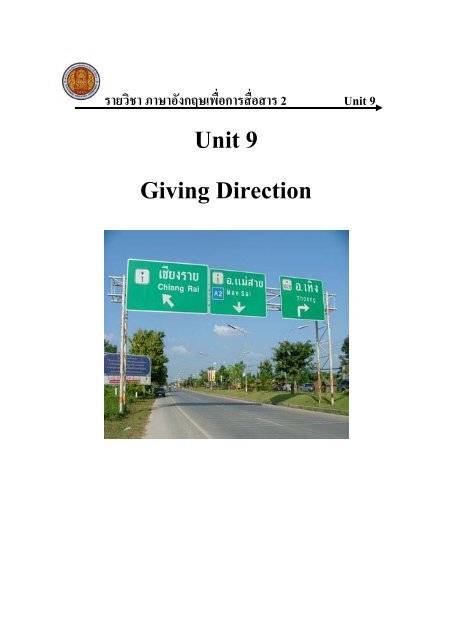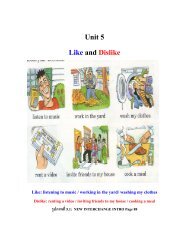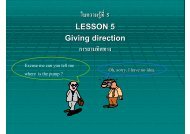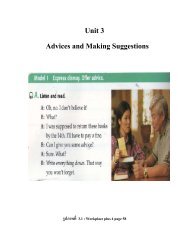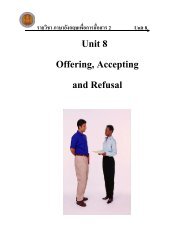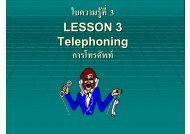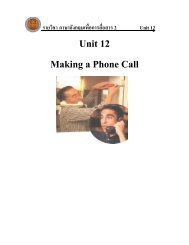Unit 9 Giving Direction
Unit 9 Giving Direction
Unit 9 Giving Direction
Create successful ePaper yourself
Turn your PDF publications into a flip-book with our unique Google optimized e-Paper software.
รายวิชา ภาษาอังกฤษเพื่อการสื่อสาร 2 <strong>Unit</strong> 9<strong>Unit</strong> 9<strong>Giving</strong> <strong>Direction</strong>
<strong>Unit</strong> 9<strong>Giving</strong> <strong>Direction</strong>สาระสําคัญในชีวิตประจําวันเราอาจจําเปนตองเดินทางไปสถานที่ที่เราไมคุนเคย หรือไมรูจักทาง ในบางโอกาส เราอาจพบบุคคลที่เปนชาวตางชาติมาสอบถามเกี่ยวกับเสนทางไปยังสถานที่ตางๆผูเรียนจึงควรเรียนรูวิธีการพูดและการเขียน อธิบายทิศทางจากสถานที่หนึ่งไปอีกสถานที่หนึ่งจุดประสงคการเรียนรูความรู1. อานออกเสียงความคําศัพท สํานวน และ Imperative Verb ที่ใชในการอธิบายเสนทางหรือวิธีการเดินทาง2. เลือกใชศัพท สํานวนและ Imperative Verb ที่ใชในการอธิบายเสนทางหรือวิธีการเดินทางไดถูกตองเหมาะสมทักษะ3. พูดสนทนาสอบถามและตอบขอสอบถามเกี่ยวกับเสนทาง วิธีการเดินทางไดถูกตอง4. วิเคราะหใชศัพท สํานวน ไวยากรณและ Imperative Verb เกี่ยวกับเสนทางหรือวิธีการเดินทางไดอยางเหมาะสมคุณธรรม5. เสริมสรางลักษณะนิสัยของการอธิบายเสนทาง หรือวิธีเดินทางเปนภาษาอังกฤษดวยความรับผิดชอบ ในการที่จะตองอธิบายใหเขาใจและถูกตองตามกาลเทศะเนื้อหาสาระ1. Language Focus : Expression and sentences in giving direction1.1 Asking the way and giving direction1.2 Asking for clarification and useful expression1.3. Asking , Accepting and Refusing1.4 Imperatives verb2. Worksheet2.1 ใบงานที่ 9.1 Warm up ศึกษาคําศัพทเกี่ยวกับการบอกทิศทางจากภาพที่กําหนด แลวหาคําศัพทที่เกี่ยวกับการบอกทิศทาง 10 คํา2.2 ใบงานที่ 9.2 Listening ดูแผนที่ แลวฟงขอความจากเทป แลวพิจารณาวาถูกตองตามแผนที่หรือไม
2.3 ใบงานที่ 9.3 Speaking ดูแผนที่แลวจับคูฝกพูดบทสนทนาสอบถามและตอบเกี่ยวกับเสนทางไปยังสถานที่ตางๆ ตามแผนที่ที่กําหนดให2.4 ใบงานที่ 9.4 Reading เรียงขอความที่กําหนดให เปนบทสนทนาเกี่ยวกับการถามทิศทางที่ไดใจความ2.5 ใบงานที่ 9.5 Writing เขียนบทสนทนาเลียนแบบตัวอยางเกี่ยวกับการสอบถามการเดินทาง โดยใชขอมูลที่กําหนดให แลวจับคูพูดบทสนทนา1. Language Focus: Expression and sentences in giving direction1.1 Asking the way and giving directionAsking the way<strong>Giving</strong> direction• Excuse me, where’s the hotel? • Turn right / left at the corner.• Excuse me, can you tell me the way to the • Turn right / left into Rama Road.library?• Take the first turning right / left.• Excuse me. How do I get to the bank from • Go up this street and turn right / left.here?• Drive down Highway.• Which way is the museum? • Go east / west / north / south on Highway• Do you know where the post office is? Road.• Walk along the road to the traffic light.1.2 Asking for clarification and useful expressionAsking for clarificationUseful expression• Up this street two blocks and left?• So I go up the intersection and turn right.• Do I take the first or the second street onthe left?• Is the bank on the right or on the left?• So for the bank, I go down two blocks andturn left?• It’s not very far.• It’s about ten minutes’ walk.• It’s about two blocks.• You can’t miss it.
1.3. Asking , Accepting and RefusingAskingDo you knowwhere there’s a bank?the (shortest) way to………?how to get to……………?where ……………is?Accepting and Refusing- Yes, there’s one on………..- Yes, you’ll find it on………..- Certainly, it’s not far.- I’m sorry. I don’t know.- I’m sorry. I have no idea.How do I get to…………?can there?Can you direct me to………….?1.4 Imperatives verbStructures: ImperativesCatchtrainTake the micro bus from…………..bus no. 17Keep straight until you see the………Walk along this road f or………..Go down till you reach the………..aheadas far as……………Imperative verbs look like "bossy" verbs: the verbs in Do this, don't do that, go away areclearly cases of throwing your weight around. Notice, incidentally, that imperative verbs likethese are always in present time. It's not possible to issue a command in the past, eg *Didn't dothat. And there is no pronoun or noun acting as a subject to the verb. If you needed to put one intothe sentence, it would have to be you, as in the kind of disagreements that sound like this:You go No- you go!Sentences like these, with an imperative verb in them, are called directive sentences.But it would be misleading to say that every directive sentence has a bossy, commandingmeaning. Look, for example, at these:
directive sentence imperative verb possible purpose of sentenceGo and see a doctor Go adviceMind out for the mosquitoes Mind (out) warningHave a nice holiday Have expression of good wishesHelp me! Help pleadingCome over here please. Come requestingCome round for a drink tonight. Come invitationOne other thing to notice about the grammar of the imperative verb: in its positive formthere is only one verb in the verb phrase (as in the examples above). If we were to turn them intonegatives - Don't go, Don't mind out, Don't have etc, then there will be two verbs, and theauxiliary will always be the imperative don't. So, if you come across "bossy" sentences like I'mtelling you now - you will go tomorrow, because I say so, it isn't an imperative verb that's beingused. It's a modal verb, making a confident prediction and giving the listener no choices.The way how to use imperativeDirect commandsRequestSuggestionWarning<strong>Direction</strong>InstructionInvitationProhibitionOfferExampleFollow me.Open the window .(please)Take first turning.Watch out! There’s a motorcycle.Go straight for 10 minutes walk.Use a microwave and boil for 5 minutes.Come and have birthday party tonight.Take off your shoes.Help yourself
PracticeConversation 1A: Where is the public library, please?B: It is in Broad Street, near the Town Hall.A: How do I get there?B: Well, you could walk. But it’s better to take a bus number 14. It will take you straightthere.A: Thanks a lot.Conversation 2A: Excuse me, could you tell me where the Scala Cinema is , please?B: Let me see. Oh yes, of course, I know. It’s in Lincoln Square, opposite the Asia Hotel.A: Is that near here?B: Oh yes, it’s just a few minutes walk. Turn left at the traffic lights and you’ll see it.A: Thank you very much.Conversation 3A: Excuse me, please. Could you tell me where the Speedy Car-Hire office is?B: I’m sorry. I have no ideaA: I think it’s somewhere off City Avenue. Do you know where that is?B: I’m afraid I don’t. I’d never been here before.
ใบงานที่9.1Warm up : Vocabulary StudyExercise 1 Study the vocabulary about the direction and find 10 words to fill in the blanksbelow.รูปภาพ 9.1 English for Communication 1 ทวี โอมาก หนา 1101………………………………………………2………………………………………………3………………………………………………4………………………………………………5………………………………………………6……………………………………………7……………………………………………8……………………………………………9……………………………………………10…………………………………………..
ใบงานที่ 9.2ListeningExercise 2: Study the map before you begin. Listen to the speaker giving directions to differentplaces on the map. Then write ‘True’ or ‘False’รูปภาพ 9.2 http://www.kr.ac.th/ebook/ben/t03.html.......... 1. The hotel is next to the bank........... 2. The zoo is opposite the police station........... 3. The library is between the post office and the supermarket............ 4. The bowling alley is on the East Street.............5. The bar is on the corner of West Street and South Street.............6. City hall is in front of the library.............7. The hospital is near the bus station.............8. The zoo is behind the post office............. 9. The bowling alley is behind the bookstore.............10. The school is between the bus station and the police station.
ใบงานที่9.3SpeakingExercise 3 You are staying with your friend who lives at 46 Calton Drive. Work in pairs.ask your friend how you can get to the places shown on the map. Notice that the road goesunder the railway.รูปภาพ 9.3 Break Through 1 J.C. Richards & M.N. Long หนา 441. The hospital.A:………………………………………………………………………………………….B:………………………………………………………………………………………….…………………………………………………………………………………………….2. The Bangkok bank.A:………………………………………………………………………………………….B:………………………………………………………………………………………….…………………………………………………………………………………………….3. The restaurant.A:………………………………………………………………………………………….B:………………………………………………………………………………………….…………………………………………………………………………………………….4. The railway station.A:………………………………………………………………………………………….B:………………………………………………………………………………………….…………………………………………………………………………………………….
ใบงานที่9.4ReadingExercise 4 Rearrange these sentences to be the complete conversations and then practicewith your partner.Conversation 1- The railway station? - Excuse me, how do I get to the station, please?- Yes, that’s right. I want to get to the railway station.- Thanks a lot. - Go straight on. It’s about a kilometer down the road, on your left.You: ……………………………………………………………………………………………Man: ……………………………………………………………………………………………You: ……………………………………………………………………………………………Man: …………………………………………………………………………………………..You: ……………………………………………………………………………………………Conversation 2- It’s about 25 minutes walk - Thank you very much.- Yes. Turn right, and then take the second turning on your left.- Excuse me. Can I get to the Central Department Store this way?- You’re welcome. - Is it far?- And do you know where the National Bank is?- Yes, it’s on this street. Keep walking for two blocks and it’s on the corner, on the right.You: …………………………………………………………………………………………Man: …………………………………………………………………………………………You: …………………………………………………………………………………………Man: …………………………………………………………………………………………You: …………………………………………………………………………………………Man: …………………………………………………………………………………………You: …………………………………………………………………………………………Man: …………………………………………………………………………………………
ใบงานที่9.5Writing and SpeakingExercise 5 Make new dialogues with the information given below.Destination Transportation Period of time Where to catch/park1. the shopping center The sky train 5 minutes At the cross road2. the airport The subway 15 minutes Two building block3. school The bus 30 minutes At the victory monument4. the golf club My car 1 hour The parking lot of the clubExample: A: How do you get to work?B: I take the bus.A: How long does it take?B: About forty-five minutes.A: Where do you catch the bus?B: There’s a bus stop near my house.Conversation 1A: ........................................................................................................................................................B: ........................................................................................................................................................A: ........................................................................................................................................................B: ........................................................................................................................................................A: ........................................................................................................................................................B: ........................................................................................................................................................Conversation 2A: ........................................................................................................................................................B: ........................................................................................................................................................A: ........................................................................................................................................................B: ........................................................................................................................................................A: ........................................................................................................................................................B: ........................................................................................................................................................
Conversation 3A: ........................................................................................................................................................B: ........................................................................................................................................................A: ........................................................................................................................................................B: ........................................................................................................................................................A: ........................................................................................................................................................B: ........................................................................................................................................................Conversation 4A: ........................................................................................................................................................B: ........................................................................................................................................................A: ........................................................................................................................................................B: ........................................................................................................................................................
AnswerExercise 11. Sorry to 2. where 3. turn 4. on 5. you’re welcome6. excuse 7. to 8. going 9. until 10. OnExercise 21.True 2. Ture 3. False 4. False 5. Ture6. False 7. True 8. False 9. True 10. FalseExercise 31. A: Do you know where is the hospital?B: Yes, go along Calton Drive, turn left into Lancaster Street. Then turn righ toOxford Road pass the railway station. The hospital is on your left.2. A: Excuse me. How do I get to the Bangkok Bank?B: Go along Calton Drive, turn left into Lancaster Street. Go straight ahead until yousee the cross road. The Bangkok Bank is on the opposite corner.3. A: Can you tell me where is the restaurant, please?B: Go along Calton Drive, turn left into Lancaster Stree. The restaurant is opposite thejunction of Lancaster Street and Oxford Road.4. A: Excuse me. Do you know how to get to the railway station?B: Go along Calton Drive and turn left into Lancaster Street. You’ll see it. It’s not far.Exercise 4Conversation 1You: Excuse me, how do I get to the station, please?Man: The railway station?You: Yes, that’s right. I want to get to the railway station.Man: Go straight on. It’s about a kilometer down the road, on your left.You: Thanks a lot.Conversation 2You: Excuse me. Can I get to the Central Department Store this way?Man: Yes, Turn right, and then take the second turning on your left.You: Is that far?Man: It’s about 25 minutes walk.You: And do you know where the National Bank is?
Man: Yes, it’s on this street, Keep walking for two blocks and it’s on the corner, onthe right.You: Thank you very much.Man: You’re welcome.Exercise 5Conversation 1 Conversation 2A: How do you get to the shopping center? A: How do you get to the air port?B: I take the sky train. B: I take the subway.A: How long does it take? A: How long does it take?B: About 5 minutes. B: About 15 minutes.A: Where do you take the sky train? A: Where do you take the subway?B: There’s the sky train station at the cross road. B: There’s the subway station for twobuilding block.Conversation 3 Conversation 4A: How do you get to the school? A: How do you get to the golf club?B: I take the bus. B: I drive my car.A: How long does it take? A: How long does it take?B: About 30 minutes. B: About 1 hour.A: Where do you take the bus? A: Where do you take your car?B: There’s the bus stop at the victory monument. B: At the parking lot of the club.


